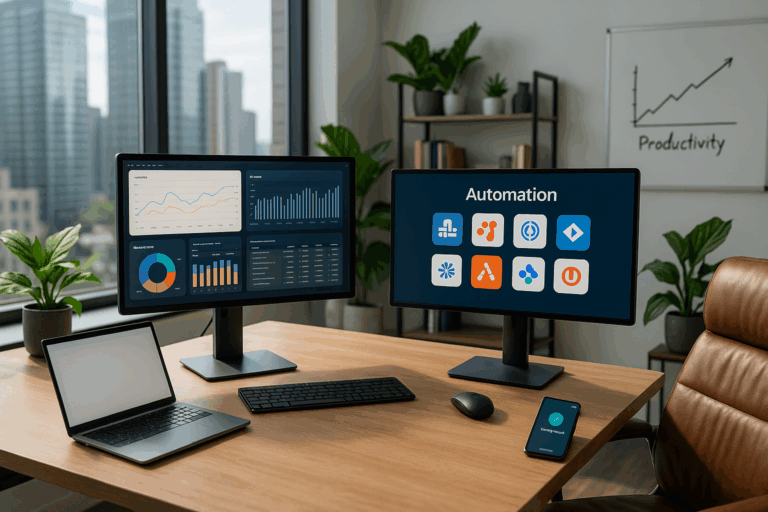Imagine this scenario: it’s nearing the end of the financial quarter and your desk is buried beneath a landslide of paper invoices. You’re wading through an ocean of numbers, desperately trying to reconcile payments, receipts, and balances. The clock ticks mercilessly as you struggle with figures that refuse to add up, an orchestra of ringing phones providing an unwanted soundtrack to your stress. Sounds familiar? If so, it’s time to streamline your accounting process with automated invoices and payments.
Automation – a term that might seem impersonal and complex, but in reality, it’s a game-changer 💡. With the power of automation at your fingertips, you can banish those manual hassles that drain your time and energy. Forget about the piles of paper, the inscrutable spreadsheets, the late-night number crunching. Automation can usher in a new era of efficiency, accuracy, and peace of mind. It’s like having your very own robotic assistant, working tirelessly behind the scenes to keep your accounts in perfect order.
Why Should You Automate?
The benefits of automating your invoicing and payment processes are manifold. Not only does it save time and resources, but it also minimizes human error and enhances accuracy. Imagine being able to generate and send invoices in seconds, schedule automatic reminders for overdue payments, and have a real-time overview of your cash flow. This is not a futuristic dream, but a tangible reality made possible by the power of modern technology.
What’s In Store For You?
Now, you might be wondering what exactly this article will cover. Well, buckle up, because we’re about to take a deep dive into the world of automated invoices and payments. We’ll explore the mechanics of how it works, the variety of tools available to you, and the practical steps you can take to integrate automation into your accounting process.
Along the way, we’ll debunk some common misconceptions, address frequently asked questions, and highlight the best practices to ensure you get the most out of automation. We’ll also share insightful case studies to illustrate the transformative impact of automation on businesses just like yours. By the end, you’ll have a comprehensive understanding of how to say goodbye to manual hassles and hello to efficiency 🚀.
Are You Ready to Embrace Automation?
Stepping into the world of automation may seem daunting, especially if you’re used to traditional accounting methods. But rest assured, this transition is not as complicated as it seems. Automation tools are designed with user-friendliness in mind, making it easy even for non-tech-savvy individuals to navigate.
Moreover, automation doesn’t mean abandoning your control over the accounting process. On the contrary, it gives you more control by providing instant access to accurate data, enabling better decision-making and strategic planning. So, are you ready to swap those late nights hunched over spreadsheets for a streamlined, stress-free accounting process? If the answer is yes, then let’s embark on this journey together.
Stay with us as we delve into the nuts and bolts of automated invoices and payments, the perfect blend of technology and finance. It’s time to transform your accounting process, replacing chaos with clarity, confusion with confidence, and hassle with harmony. Let’s get started! 🚀
Embrace the Revolution: Transform Your Accounting with Automation
Accounting is the lifeline of every business. But often, the challenges of maintaining accurate records, invoicing, and payments can be daunting and time-consuming. This is where automation comes in. With advancements in technology, businesses can now automate their accounting processes, freeing up valuable time and increasing efficiency. In this article, we’ll delve into how automation can streamline your accounting, reducing manual hassles and ushering in a new era of efficiency.
But what does automation really entail? At its core, it involves using software to automate manual tasks. In the context of accounting, this could mean automatic invoicing, reminders for late payments, and even automated reconciliation of transactions. Let’s take a deep dive into the advantages of this game-changing approach.
Before we dive into the details, if you’re a visual learner, I recommend watching this insightful video titled “How automation is changing work” from The Economist on YouTube. It gives a broad view of how automation is revolutionizing different industries, including accounting.
Understanding Automated Invoices and Payments
One of the most significant aspects of accounting automation is the generation of automated invoices and payments. But what does that mean? Essentially, it’s about using software to generate invoices and process payments without the need for human intervention. This can drastically reduce the time it takes to process each invoice and ensure that each transaction is recorded accurately in your accounting system.
The beauty of automated invoicing is that it can be customized to fit your business’s needs. For instance, you can set up recurring invoices for regular customers, send out automatic payment reminders, and even automatically apply late fees to overdue accounts.
Automated payments, on the other hand, allow for efficient and timely payment processing. With automation, you can schedule payments for specific dates, ensure timely disbursement, and eliminate the risk of human error. The software can also reconcile payments with invoices, providing a real-time overview of your financial status.
A Comparative Look at Manual Vs. Automated Accounting
To truly understand the impact of automation on accounting, let’s take a comparative look at manual and automated processes. The table below summarizes the key differences between the two approaches.
| Manual Accounting | Automated Accounting |
|---|---|
| Time-consuming, prone to human error. | Efficient, reduces errors. |
| Requires constant monitoring and follow-up. | Automated reminders and notifications make tracking easier. |
| Difficult to scale as business grows. | Easily scalable with business growth. |
As you can see, while manual accounting can serve smaller businesses or freelancers, it becomes increasingly cumbersome and prone to errors as your business grows. Automated accounting, on the other hand, offers scalability, efficiency, and accuracy, regardless of the size of your business.
If you’re still unsure about making the transition, this video “Manual Vs. Automated Accounting” by BiggerPockets Business Podcast on YouTube provides a detailed discussion on the topic. It offers valuable insights into the pros and cons of both approaches, helping you make an informed decision.
Choosing the Right Accounting Automation Software
Now that we’ve established the benefits of automating your accounting, the next step is choosing the right software. With a myriad of options available, this can be a daunting task. However, by considering a few key factors, you can find a solution that perfectly fits your business needs.
First, consider the size and complexity of your business. Small businesses might not require extensive features and can opt for simpler, more straightforward software. Larger businesses, on the other hand, might need a more robust system with advanced features like multi-currency support, inventory tracking, and integration with other business systems.
Secondly, take into account your budget. While automating your accounting will save you money in the long run, you’ll still need to consider the initial cost of the software. Fortunately, there are options available for every budget, from free software for small businesses to advanced systems for larger corporations.
Lastly, consider the software’s user-friendliness. A system that’s difficult to navigate can slow down your operations and lead to errors. Opt for software that’s intuitive and easy to use, with clear instructions and support available.
Remember, the goal of automating your accounting is to streamline your processes and increase efficiency, so choose a solution that will help you achieve this.
Final Thoughts
In the digital age, businesses can’t afford to get left behind. Embracing automation in your accounting processes can save you time, reduce errors, and give you a clear, real-time overview of your financial status. Say goodbye to manual hassles and hello to efficiency with automated invoices and payments.
So, why wait? Start exploring the options available and make the transition to automated accounting today. Your future self will thank you! 🚀

Conclusion
In conclusion, we have navigated through the often intricate landscape of advanced software engineering and its underpinning concepts. We started with the fundamentals, dissecting the meaning and implications of software engineering, a discipline that remains vital in our increasingly digital world. 🌐
We delved into the world of algorithms, the backbone of software engineering, essential in problem-solving and shaping the functionality of our digital tools. From there, we moved into the concept of data structures, a critical tool used to organize, store and manage data efficiently. We emphasized the importance of understanding both topics and their interrelation, as they form the bedrock upon which software applications are built.
Next, we journeyed into the realm of programming paradigms, exploring the different approaches like Procedural, Object-Oriented, and Functional programming. Each with their strengths and weaknesses and each playing a significant role in software development.
We discussed various programming languages, like Python, JavaScript, and Java, and their individual merits and best-use cases. We also touched on their syntaxes and semantics, giving a glimpse of their operational peculiarities and compatibilities.
We then moved on to discussing software development models such as the Waterfall Model, Agile, Scrum, and DevOps, demonstrating the evolution of software development strategies over the years. Each model has its pros and cons, with its suitability depending on the specific requirements of the project at hand.
We explored the importance of good software design and its crucial role in facilitating maintenance, increasing efficiency, and reducing resource wastage. We also highlighted the significance of software testing, an indispensable part of the software development process that ensures functionality, reliability, and user-friendliness of software products.
Lastly, we examined the ethical implications of software engineering, emphasizing the responsibility that software engineers bear in creating software that respects user privacy and safety.
In a world where technology is rapidly evolving, understanding these concepts and staying updated is key for anyone involved in software engineering. 💡
There’s always more to learn, to explore, and to apply. So, continue to dive deep, keep learning, and keep innovating. Your engagement is valuable and contributes to a collective wealth of knowledge, so feel free to leave a comment below, share this article with your peers, or apply what you’ve learned in your next project. 👩💻👨💻
For more in-depth knowledge, I encourage you to explore the following resources:
1. [MIT OpenCourseWare – Introduction to Algorithms](https://ocw.mit.edu/courses/electrical-engineering-and-computer-science/6-006-introduction-to-algorithms-fall-2011/)
2. [Stanford University – Data Structures and Algorithms](https://online.stanford.edu/courses/soe-ycsalgorithms1-algorithms-design-and-analysis)
3. [Harvard University – Web Programming with Python and JavaScript](https://www.edx.org/professional-certificate/cs50s-web-programming-with-python-and-javascript)
4. [Scrum.org – Professional Scrum Master Training](https://www.scrum.org/professional-scrum-master-i-certification)
Remember, as the digital world continues to evolve, so too should our knowledge and skills. The journey may be challenging, but the rewards are immense. Happy coding! 💪
References:
1. Pressman, R. S. (2010). Software Engineering: A Practitioner’s Approach. New York: McGraw-Hill.
2. MIT OpenCourseWare. (2011). Introduction to Algorithms. [online] Available at: https://ocw.mit.edu/courses/electrical-engineering-and-computer-science/6-006-introduction-to-algorithms-fall-2011/
3. Stanford University. (n.d.). Data Structures and Algorithms. [online] Available at: https://online.stanford.edu/courses/soe-ycsalgorithms1-algorithms-design-and-analysis
4. Harvard University. (n.d.). Web Programming with Python and JavaScript. [online] Available at: https://www.edx.org/professional-certificate/cs50s-web-programming-with-python-and-javascript
5. Scrum.org. (n.d.). Professional Scrum Master Training. [online] Available at: https://www.scrum.org/professional-scrum-master-i-certification



